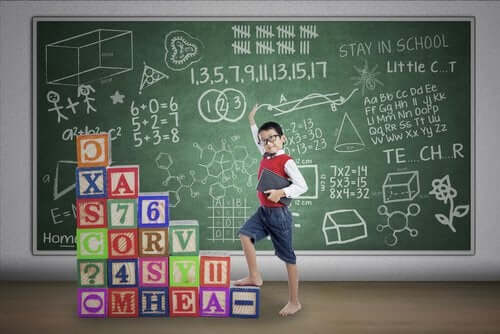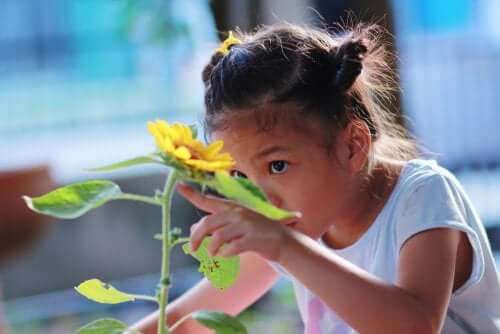How Do Children Acquire New Knowledge?

As the English philosopher John Locke said, children are a blank slate. Their mind is a blank slate ready to be filled with new information, ideas and concepts through their experiences in life. The process by which children acquire new knowledge was described by the Swiss psychologist Jean Piaget.
His contributions to the study of childhood knowledge acquisition led to the creation of a developmental theory that accounts for the way children learn and reach milestones in their development. His theory about the acquisition of new knowledge by young children focuses on the concept of adaptation. This is because, according to Piaget, learning is synonymous with adapting to new environments.
Children acquire new knowledge through the process of adaptation
Learning only makes sense in the context of changing circumstances. Experiencing these new situations produces a qualitative leap that helps us to internalize new knowledge. To understand this process, it’s essential to highlight the role of cognitive schemas.
Schemas are an organization of ideas that act as a map, a type of mental representation. They constitute the basis for interpreting the area under study and for moving forward with that information.
In this way, for example, for most children, their family schema is made up of a mother, a father and a child. This is because this is the real situation they know and experience every day.

When a new situation or a change occurs, then we have to allocate it a place in our mental organization. This is the new information that forces us to expand or modify our schemas so that they’ll continue to be useful to us.
This reorganization of the schema takes place through two different, but complementary, processes: assimilation and accommodation. Through them, we seek a balance between novelty and change. In some situations, it will be necessary to maintain the ideas we’ve already established. However, in others, we’ll need to modify them.
Assimilation
Assimilation refers to the process by which we shape new information into existing patterns. In this case, the children face their environment using the mental organization they already possess, and then incorporate the new data into it.
In some way, they tend to modify the experience, so that it fits in with what they already know. However, this is the simplest method of acquiring new information, as it doesn’t require much adjustment.
For example, a child sees a horse for the first time and says that it’s a big dog. Or they see a shovel on the beach for the first time and, because of the similarity in shape, thinks that it’s a huge spoon. The child is, therefore, assimilating the new information based on what they already know.
Accommodation
Accommodation is the process by which the child modifies his or her mental patterns according to the demands of the environment. In the previous case, they modified the new information to fit the existing schemas. However, in this case, the schemas will change in order to adapt to the new experience.

Let’s go back to the example we gave before about the child whose family schema was a father, a mother, and them. Let’s now imagine that the child’s parents divorce and they start living with their mother and her new partner. In this way, their mental conception of what a family is will have to change in order to accommodate the new circumstances that they’ve experienced.
Likewise, the child who thought that the shovel was a giant spoon, when they understand that one is used to eat and the other to play, then they’ll have to modify their schemas. If the child doesn’t do this, then these schemas will no longer be useful to them in understanding their environment and relating to it.
Not only children acquire new knowledge
As we’ve observed, the processes used by children to understand their environment are both complex and fascinating. However, this isn’t exclusive to childhood. We adults still use assimilation and accommodation when we learn a new language, a new recipe, or start to use a new computer program or app.
From the time we’re born until the time we die, we never stop acquiring new information and knowledge. If this just requires a small adjustment then we’ll be assimilating. However, when we need to modify our basic schemas, then we’ll be putting into practice accommodation.
As the English philosopher John Locke said, children are a blank slate. Their mind is a blank slate ready to be filled with new information, ideas and concepts through their experiences in life. The process by which children acquire new knowledge was described by the Swiss psychologist Jean Piaget.
His contributions to the study of childhood knowledge acquisition led to the creation of a developmental theory that accounts for the way children learn and reach milestones in their development. His theory about the acquisition of new knowledge by young children focuses on the concept of adaptation. This is because, according to Piaget, learning is synonymous with adapting to new environments.
Children acquire new knowledge through the process of adaptation
Learning only makes sense in the context of changing circumstances. Experiencing these new situations produces a qualitative leap that helps us to internalize new knowledge. To understand this process, it’s essential to highlight the role of cognitive schemas.
Schemas are an organization of ideas that act as a map, a type of mental representation. They constitute the basis for interpreting the area under study and for moving forward with that information.
In this way, for example, for most children, their family schema is made up of a mother, a father and a child. This is because this is the real situation they know and experience every day.

When a new situation or a change occurs, then we have to allocate it a place in our mental organization. This is the new information that forces us to expand or modify our schemas so that they’ll continue to be useful to us.
This reorganization of the schema takes place through two different, but complementary, processes: assimilation and accommodation. Through them, we seek a balance between novelty and change. In some situations, it will be necessary to maintain the ideas we’ve already established. However, in others, we’ll need to modify them.
Assimilation
Assimilation refers to the process by which we shape new information into existing patterns. In this case, the children face their environment using the mental organization they already possess, and then incorporate the new data into it.
In some way, they tend to modify the experience, so that it fits in with what they already know. However, this is the simplest method of acquiring new information, as it doesn’t require much adjustment.
For example, a child sees a horse for the first time and says that it’s a big dog. Or they see a shovel on the beach for the first time and, because of the similarity in shape, thinks that it’s a huge spoon. The child is, therefore, assimilating the new information based on what they already know.
Accommodation
Accommodation is the process by which the child modifies his or her mental patterns according to the demands of the environment. In the previous case, they modified the new information to fit the existing schemas. However, in this case, the schemas will change in order to adapt to the new experience.

Let’s go back to the example we gave before about the child whose family schema was a father, a mother, and them. Let’s now imagine that the child’s parents divorce and they start living with their mother and her new partner. In this way, their mental conception of what a family is will have to change in order to accommodate the new circumstances that they’ve experienced.
Likewise, the child who thought that the shovel was a giant spoon, when they understand that one is used to eat and the other to play, then they’ll have to modify their schemas. If the child doesn’t do this, then these schemas will no longer be useful to them in understanding their environment and relating to it.
Not only children acquire new knowledge
As we’ve observed, the processes used by children to understand their environment are both complex and fascinating. However, this isn’t exclusive to childhood. We adults still use assimilation and accommodation when we learn a new language, a new recipe, or start to use a new computer program or app.
From the time we’re born until the time we die, we never stop acquiring new information and knowledge. If this just requires a small adjustment then we’ll be assimilating. However, when we need to modify our basic schemas, then we’ll be putting into practice accommodation.
All cited sources were thoroughly reviewed by our team to ensure their quality, reliability, currency, and validity. The bibliography of this article was considered reliable and of academic or scientific accuracy.
- de Piaget, T. D. D. C. (2007). Desarrollo Cognitivo: Las Teorías de Piaget y de Vygotsky. Recuperado de http://www.paidopsiquiatria.cat/archivos/teorias_desarrollo_cognitivo_07-09_m1.pdf
- Piaget, J. (1981). La teoría de Piaget. Infancia y aprendizaje, 4(sup2), 13-54.
This text is provided for informational purposes only and does not replace consultation with a professional. If in doubt, consult your specialist.








